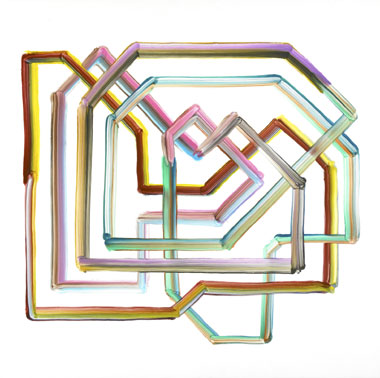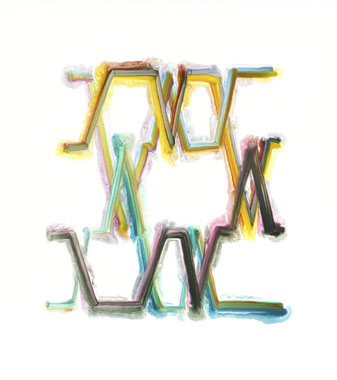 |
| Bernard Frize: Usine, 2005, acrylic and resin on canvas, 150 x 150 cm; courtesy Galerie Emmanuel Perrotin |
Within contemporary abstract painting, Bernard Frize’s virtuoso canvases seem to provoke a welcome variation on the ill-advised question ‘what is it about?’ that is ‘how is it done?’ As with the best painting being produced today, Frize’s work has, for many years now, consistently yet without turning into stale repetition, explored to great effect a highly specific visual vocabulary. His works seem to be predicated upon the same visual conceit: the interweaving of highly viscous brushstrokes within whose final pattern the viewer becomes lost in their attempt to locate the origin of gestures, the sophistication of which being at odds with their apparent immediacy.
The brush, or in this case two or more brushes held together like a bunch of flowers, each one loaded with a different colour, produce(s) a pattern which intersects itself without, apparently ever leaving the surface of the canvas. A line produced in a certain direction appears to double back at a later point and pass under itself. Lucid gestures duck and weave under and over both each other and themselves, wet into wet on a sumptuously satinated resin ground. The eye is preoccupied from the first encounter with the deceptive simplicity of what is being done. A line of a certain colour traverses another of an entirely different colour and trajectory, now crossing over, now below, without any great compromise to either one. It is as though the painted lines have been braided and woven in zero gravity, where their pigments are less inclined to co-opt one another, and only once the order of their correspondence has finally been decided upon that they are allowed to come to rest on the canvas. The effect is reminiscent of a 3-D model of DNA.
 |
| Bernard Frize: Diamant, 2005, acrylic and resin on canvas, 190 x 190 cm; courtesy Galerie Emmanuel Perrotin |
It is no great relief to be given an insight into how these works are produced. Frize employs a highly choreographed method of painting that involves three assistants. Following a series of guide pencil marks, which are incidentally left visible in the final piece, the brushstrokes are worked over each other in an astounding feat of timing. This information only leaves us to wonder at the series of movements involved, like listening to a ballet on the radio.
To anyone who has tried to repeat a fluid effect with paint, the failures implicit in the task will be familiar. These works, however, are about more than simply a measured spontaneity. In a sense they could be termed durational. They seem to record and hold time like a fly in amber. In this case, the time in question is the moment of their production; somehow they appear still wet, still active. This seems to be achieved in part through the fluidity of the paint, worked onto the ground while it is still damp. The network of painted lines and stitches, by virtue of this fluidity, look as flexible as woven cloth; an elegant mimicry of the canvas support. The canvas weave itself, however, is almost concealed beneath a sensual coat of resin. Without the grain of the support, the paint alone serves to hold meaning within its complex weave.
If we are to read these surfaces in terms of their immediacy, then this reading is necessarily disrupted in the process of tracing the pattern and trajectory of the brushstrokes. In this sense Frize has succeeded in making the question ‘how is it done?’ equivalent to the question ‘what is it about?’ Our search for meaning here becomes a matter of production and deconstruction. The viewer may approach these works in quite the same way they would approach a photorealist painting. Both works become reducible to the level of technique. If part of Frize’s
 |
| Bernard Frize: Quatre fois trois.D, 2005, acrylic and resin on canvas, 130 x 115 cm; courtesy Galerie Emmanuel Perrotin |
project is to point to a misdirected interpretive impulse with regard to abstraction, that is, that an abstraction somehow holds meaning in and of itself, then it is a successful strategy.
The limited term ‘process painting’ was coined to describe a certain type of work which foregrounded ideas of production through the rigour of technique. Like a long-running science experiment, it did not make claims for itself beyond the physical evidence of canvas and paint. This anodyne image of art as philosophical / scientific inquiry is enhanced by mundane titles that read more like chemical formulae. In critical terms the jargon surrounding abstract painting as akin to some kind of alchemical process was replaced by a more rational response.
 |
| creating a Bernard Frize painting: image held here |
Of course if painting were really reducible to a formula it would make for a bland enterprise. One of the things good abstract work can demonstrate is that all painting is ‘process painting’ and that painting in itself has as much to do with articulating meaning as Newton’s theory of gravity has to do with apples. Whether or not the painted gesture actually holds meaning, it is certain that in the work of Bernard Frize it still holds wonder.
Robbie O’Halloran is an artist based in Paris.
An exhibition of his painting will be on show at the Lemonstreet Gallery, Dublin in September.